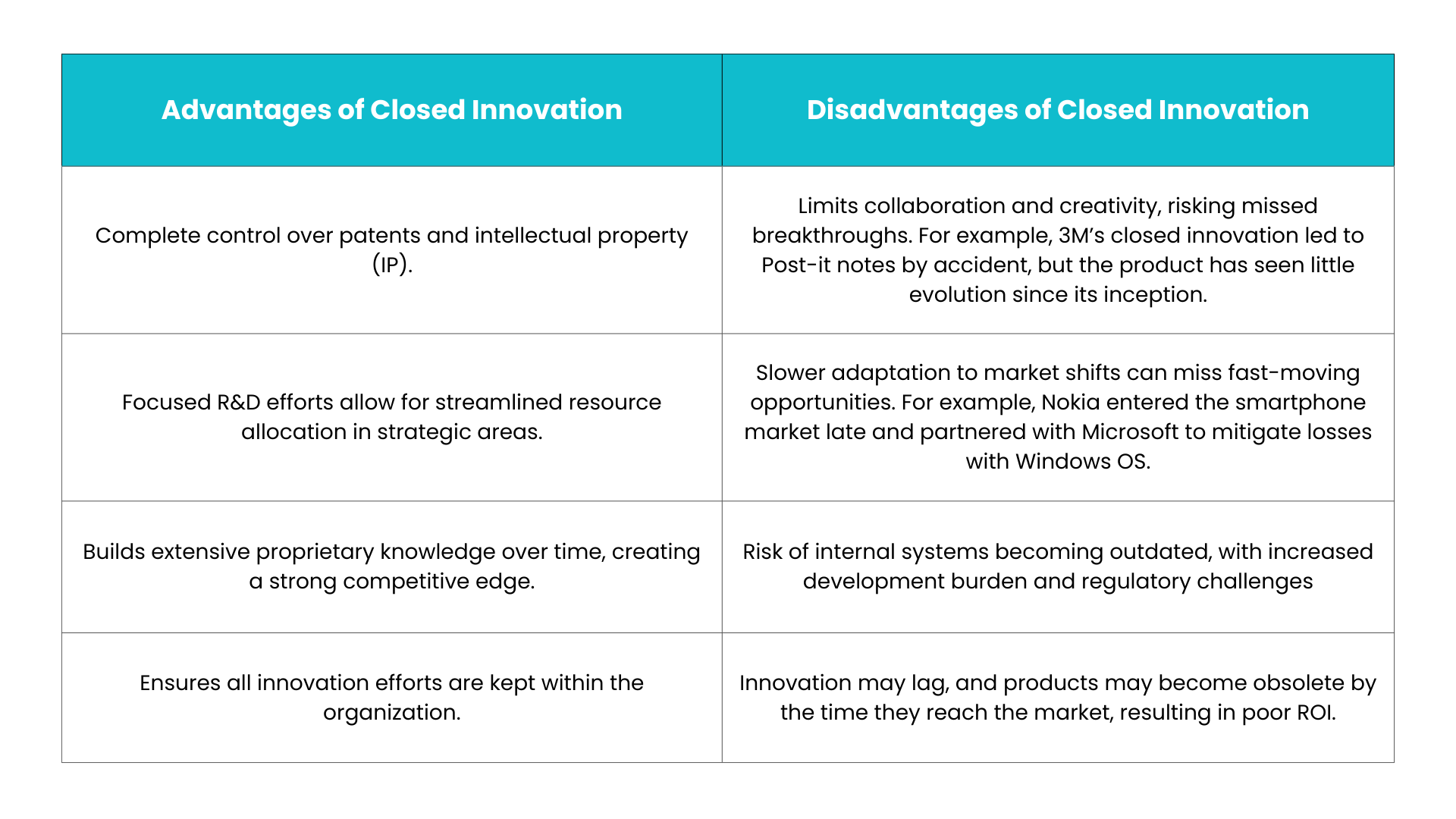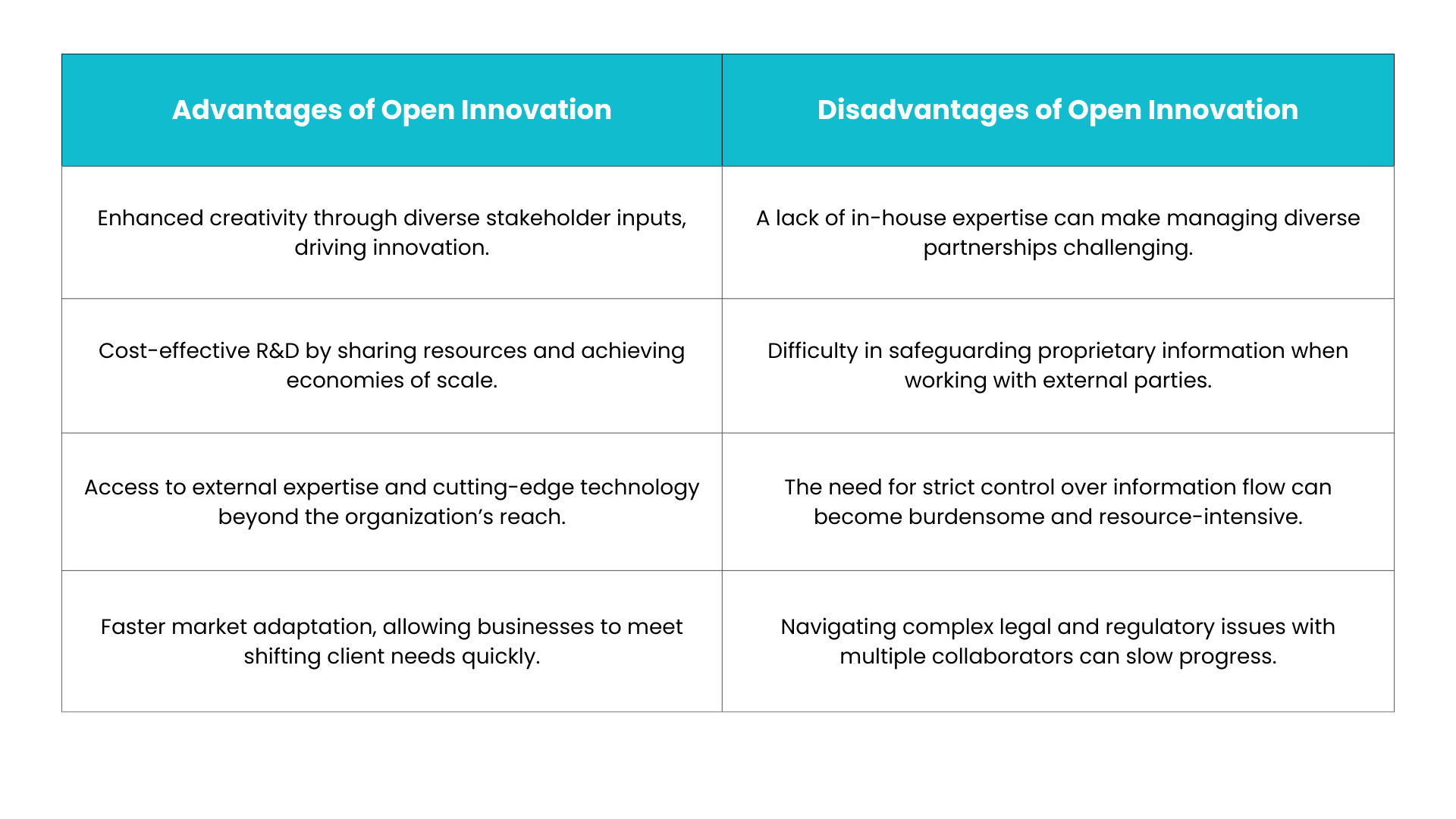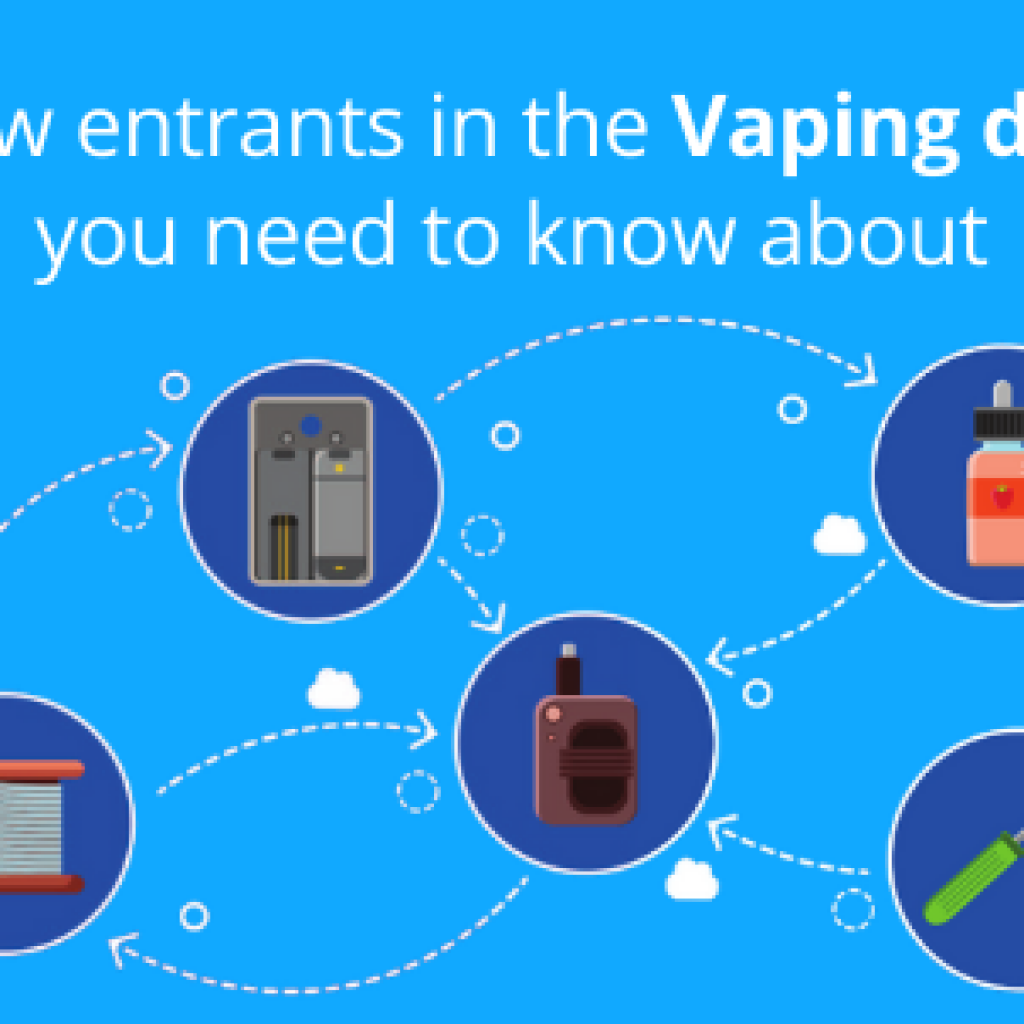The top 50 innovative companies beat the MSCI World Index by 3.3% annually, proving innovation boosts operations and investor returns.
But the question remains: how should companies approach it – closed or open?
A McKinsey study that surveyed over 650 businesses indicated that businesses that prioritized innovation and followed best practices achieved a total shareholder return above their industry median between 2012 and 2022.
While closed innovation focuses on internal resources, open innovation leverages external collaboration. However, the choice between the two often depends on factors such as industry dynamics, company culture, and the nature of the innovation challenge.
The entire process requires strategic decision-making.
But why does the difference between closed and open innovation matter?
Businesses purely relying on closed innovation have the advantage of having complete control over their R&D and intellectual property. However, market opportunities may be challenging to capture, and products may take longer to develop.
This is where open innovation can help them keep pace with changing market conditions and customer needs.
Therefore, choosing between open vs closed innovation is integral to the company’s growth strategy and willingness to share intelligence.
Closed Innovation: A Linear Choice
Closed innovation occurs when a business builds products and services by only harnessing its internal resources. Historically, this approach has been dominant, spearheaded by a company’s large, centralized R&D department.
Here are some of its key aspects:
- Internal focus: Relies primarily on internal resources and capabilities for idea generation and product development.
- Secrecy and intellectual property: Emphasizes protecting intellectual property and maintaining confidentiality around innovations.
- Linear innovation process: Follows a sequential process from idea conception to commercialization within the organization.
- Limited external collaboration: Engages minimally with external entities for input or partnerships in the innovation process.
- Self-sufficiency: Assumes that the organization has all the necessary resources and expertise to innovate independently.
Companies leveraging closed innovation
Pfizer
Pfizer employs closed innovation strategies and focuses on internal R&D to develop drugs. This approach has led to advancements in cardiovascular, metabolic, rare disease, immunology and inflammation, neuroscience and pain, oncology, and vaccines.
Ford Motor Company
Historically, Ford has designed and manufactured vehicles internally, relying on its R&D capabilities.
Apple
Apple Inc. is well-known for its secretive approach to innovation. It keeps new product development in-house and keeps upcoming launches under wraps. This closed model allows Apple to retain a competitive edge by keeping its cards close to its chest until the big reveal.
However, they’ve also adopted some open innovation, allowing third-party app developers to form strategic partnerships for external technology integration. One example is Apple’s expansion into the healthcare sector.
Open Innovation: Branching out
Open innovation actively seeks external ideas, knowledge, and technologies to complement internal resources and capabilities. This model contrasts sharply with closed innovation, which relies solely on internal resources for product and service development.
Here are the key characteristics of open innovation:
- Collaboration: Actively seeks partnerships with external entities.
- External inputs: Incorporates ideas and technologies from outside the organization.
- Knowledge sharing: Encourages the exchange of ideas across boundaries.
- Inbound and outbound innovation: Utilizes both external ideas and licenses internal innovations.
- Iterative and agile: Promotes flexibility and continuous feedback in the innovation process.
Businesses leveraging open innovation
Procter & Gamble’s (P&G) initiative Connect + Develop
Launched in 2002, the program helped launch over 35% of P&G’s new products by 2014. The company collaborates with entrepreneurs, patent-holders, academia, research institutes, suppliers, and financial institutions to accelerate innovation and reduce costs.
Coca-Cola’s freestyle dispenser machine
This company crowdsourced suggestions from consumers by allowing them to mix flavors and submit new combinations via a smartphone app. This way, the company launched its first consumer-inspired flavor, Sprite Cherry, in 2017.
Mozilla
Utilizes the Mozilla Open Innovation Program to invite community contributions for new features and product ideas for the Firefox browser.
How do you choose between Closed vs Open Innovation?
To make an informed choice, businesses need to weigh the advantages and disadvantages of open innovation vs closed innovation approaches:


Closed vs Open Innovation: A 3 Point Checklist for R&D Leaders
The following strategic considerations help R&D leaders weigh the advantages and disadvantages of open and closed innovation against their company’s goal. Consider this a checklist when shaping your innovation strategies:
1. Assess company goals and resources
- Align innovation strategies with the company’s overall business objectives to achieve higher ROI on efforts. For example, when P&G realized that to sustain long-term growth and remain competitive, they needed to innovate faster and more efficiently than possible with an exclusively closed approach, they shifted to the “Connect + Develop” strategy. This enabled P&G to collaborate with external partners, including universities, suppliers, and competitors, to bring new products to market.
- Evaluate internal capabilities and the availability of resources—from human capital and funding to data and infrastructure. For example, when Apple needed to expand into the healthcare segment, the giant transitioned from a closed model to a collaborative one and acquired startups with medtech capabilities.
- Conduct a Strengths, Weaknesses, Opportunities, and Threats (SWOT) analysis to gauge the company’s capabilities and potential risks related explicitly to launching a new product line in a particular market.
- Consider resource availability and assess your budget for R&D. Open innovation can often be more cost-effective, as it allows companies to leverage external research and development, potentially reducing the financial burden of in-house efforts. For example, Unilever’s open innovation initiatives have contributed to developing products like compressed deodorant cans, which use less packaging and result in lower production and transportation costs. This not only aligns with their sustainability goals but also delivers cost savings. As of 2013, around 55% of Unilever’s product pipeline was generated through open innovation activities.
2. Review industry dynamics and competitive landscape
- Cultivate a realistic understanding of industry trends and competition levels.
- Build an in-depth understanding of how to identify when to adopt open vs closed innovation based on current market conditions.
- Analyze which innovation model can accelerate product development and improve adoption and customer engagement.
3. Outline implementation strategies
- Develop a structured process to transition from a closed to an open innovation model.
- Identify and appoint a dedicated leader to steer the open innovation arm, define clear goals and outcomes, and stay accountable for its end-to-end management.
- Find the right tech stack for various divisions for successful open innovation. This includes tools like innovation management software and open innovation platforms.
- Establish partnerships with external stakeholders such as research institutes, entrepreneurs, and inventors.
- Foster an open innovation culture. This involves cross-departmental support, innovation-focused initiatives, and rewarding contributors.
Some Recommendations for R&D Heads
Hybrid approach
Consider a hybrid approach that leverages both models effectively and derives their unique benefits. For example:
- Amazon Custom is an initiative that allows vendors to sell customizable products on the platform. This hybrid strategy blends open innovation by incorporating customer feedback into product development. It has enabled Amazon to refine its offerings continuously and respond quickly to market demands.
- Nestlé employs a hybrid approach through its ‘InGenius’ global innovation accelerator, which encourages internal collaboration among employees, and the ‘Henri@Nestle’ project, which invites startups to pitch innovative ideas.
Control of IPs
While controlling IP in open innovation can be challenging, companies can strategize to leverage it and maintain a competitive edge in the industry. Adoption of open innovation can help expand your IP portfolio and protect critical technologies, thus creating a moat.
Establish collaborative ecosystems
This helps integrate various stakeholders, including startups, universities, and research institutions. This model allows for the sharing of resources, knowledge, and expertise while maintaining a degree of control over proprietary technologies.
For instance, automotive companies like Toyota have partnered with tech startups and universities to co-develop new technologies.
Invest in external consultation to make a fool-proof innovation strategy
To choose which innovation model can optimize your company’s growth, it’s crucial to analyze your industry landscape. For example, while open innovation has unique advantages, businesses often face challenges in effectively managing collaboration with various stakeholders in an external setup.
This is where expert consultation makes your decisions much more effective.
As an innovation and intellectual property (IP) research and consulting firm, GreyB looks into more than 18 parameters to offer expert guidance and support in developing and implementing effective open innovation strategies.
From providing a major food company with strategic guidance across packaging material and processes to decarbonize their supply chain using life cycle assessments to developing ideas for a Fortune 500 FMCG company to expand into the alternate protein market using the PESTEL analysis, our evaluations have led to actionable recommendations for market entry strategies and potential collaborations.
Streamline your innovation process while reducing costs and driving more value to the project with GreyB.
To learn more, talk to us today!











